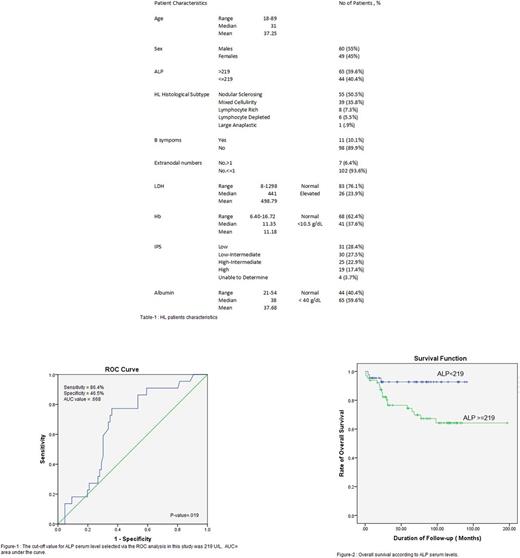Abstract
Background
Hodgkin lymphoma (HL) is a potentially curable lymphoma with distinct histology, biologic behavior, and clinical characteristics. It is among the neoplastic diseases that has the best long-term outcome after treatment. Cure rates approach 80-90%; however, 15-20% of patients will be resistant to therapy or relapse after treatment. International Prognostic Score (IPS) is The most widely utilized clinical index to assign risk in HL patients. Alkaline Phosphatase (ALP) comprises a group of enzymes that catalyze the hydrolysis of phosphate esters in an alkaline environment, generating an organic radical and inorganic phosphate .ALP presents in all human tissues, but it's highest concentrations are found in the liver, bones, kidneys and placenta. Elevated ALP serum levels was shown to be a bad prognostic factor in patient with metastatic colorectal and breast cancers.
Aim
To study the prognostic role of ALP serum level at time of diagnosis in HL patients.
Methods
109 patients diagnosed with HL between January 2004 to December 2016 were retrospectively reviewed at King Abdullah University Hospital (KAUH) . Clinical and laboratory data at time of diagnosis including gender, age, presenting symptoms, ALP level, Complete Blood Count (CBC), Lactate Dehydrogenase (LDH) level, pathological subtypes, CT and PET/CT scans were studied. All IPS 7 variables including: male sex, age >45 years, stage IV disease, hemoglobin (Hb) <10.5g/dl, white blood count (WBC) ≥ 15 × 109/L, lymphocyte count < 0.6 × 109/L or <8% of total WBC, and albumin < 40g/dL were recorded at time of diagnosis. Extranodal involvement was confirmed by tissue diagnosis. All our patients received the same ABVD treatment regimen. The optimal cut-off value for ALP level was obtained using the Receiver Operating Curve (ROC) with a determination of the sensitivity and specificity . We analyzed for associations between ALP serum level and patient characteristics. Data were assessed using the Kaplan-Meier method, and the log-rank test was utilized to compare survival time between the groups.
Results
The median age at diagnosis was 31 years (Range = 18-89 years). 55% were males and 45% were females. Patient characteristics are summarized in the table. Median ALP serum level was 250 U/L (range , 88-1234) and the optimal cutoff value of ALP serum level for predicting overall survival (OS) was 219 U/L (Sensitivity 86.4% , Specificity 46.50%; area under the curve [AUC] value: 0.668, 95% confidence interval [CI] 0.548-0.778, P= 0.019). In univariate analysis, elevated ALP level was significantly associated with poorer OS (HR=4.21, 95% CI: 1.24-14.26 , P-value=0.012). Mean survival time for patients with high ALP level was 11.68 years , compared to patients with low ALP level 10.96 years. In multivariate analysis ,there was significant association between high serum ALP level and IPS (P-value<.001), low Hb level (P-value=.002) , low Albumin level (P-value=.001) and high LDH level (.019). Involvement of more than one extra-nodal site was associated with poorer OS (HR=4.35 ,95% CI: 1.23-15.34 , P-value=0.022). There was no significant association between high ALP level and bone involvement (P-value=.072) ,liver involvement (P-value=.12) and HL subtype (P-value=.45).
Summary
ALP serum level may be a useful and un-expensive prognostic marker in patient with HL. The OS rate in patient with high ALP serum level at time of diagnosis is significantly lower than OS rate in patients with low serum levels. High ALP level is significantly associated with high IPS score , more than one EN site involvement , low Hb level , low albumin level and high LDH level.
No relevant conflicts of interest to declare.
Author notes
Asterisk with author names denotes non-ASH members.


This feature is available to Subscribers Only
Sign In or Create an Account Close Modal